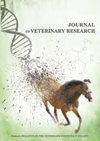Echinococcus multilocularis genetic diversity based on isolates from pigs confirmed the characteristic haplotype distribution and the presence of the Asian-like haplotype in Central Europe
IF 1.3
3区 农林科学
Q2 VETERINARY SCIENCES
引用次数: 0
Abstract
Abstract Introduction The aim of the study was to determine the genetic diversity of Echinococcus multilocularis in pigs in highly endemic areas in Poland, as well as to attempt to confirm the occurrence and geographical distribution of haplotypes characteristic for these areas, which were previously described on the basis of examination of adult tapeworms isolated from foxes. Material and Methods Twenty samples of E. multilocularis larval forms were obtained from pigs’ livers in four provinces of Poland. Genetic analyses were conducted on sequences of two mitochondrial genes: cox1 and nad2. Results Seven haplotypes were found for the cox1 gene (OQ874673–OQ874679) and four haplotypes for nad2 (OQ884981–OQ884984). They corresponded to the haplotypes described earlier in foxes in Poland (some of them differing only in one nucleotide). The analysis showed the presence of the Asian-like haplotype in both the cox1 and nad2 genes. The remaining haplotypes were grouped in the European clade. The geographical distribution of haplotypes identified in the pig samples was noticed to bear a similarity to the distribution of haplotypes previously isolated from foxes in the same regions. Conclusion The characteristic geographical distribution of E. multilocularis haplotypes in Central Europe (including the presence of the Asian-like haplotype) previously described in the population of definitive hosts (foxes) has now been confirmed by the analysis of samples from non-specific intermediate hosts (pigs).基于猪分离物的多房棘球绦虫遗传多样性证实了其特征性单倍型分布和亚洲样单倍型在中欧的存在
本研究的目的是确定波兰多房棘球蚴高流行区猪的遗传多样性,并试图确认这些地区单倍型特征的发生和地理分布,这些特征先前是在检测从狐狸中分离的成年绦虫的基础上描述的。材料与方法从波兰4个省的猪肝脏中采集了20种多房棘球绦虫幼虫。对线粒体cox1和nad2基因序列进行遗传分析。结果cox1基因共有7个单倍型(OQ874673-OQ874679), nad2基因共有4个单倍型(OQ884981-OQ884984)。它们与先前在波兰的狐狸中描述的单倍型相一致(其中一些只在一个核苷酸上有所不同)。分析表明,在cox1和nad2基因中都存在亚洲样单倍型。其余的单倍型被归为欧洲进化支。在猪样本中发现的单倍型的地理分布与先前在同一地区从狐狸中分离到的单倍型分布相似。结论中欧多房棘球绦虫单倍型的特征性地理分布(包括亚洲样单倍型的存在)先前在最终宿主(狐狸)群体中被描述,现在已通过对非特异性中间宿主(猪)样本的分析得到证实。
本文章由计算机程序翻译,如有差异,请以英文原文为准。
求助全文
约1分钟内获得全文
求助全文
来源期刊

Journal of Veterinary Research
Veterinary-General Veterinary
CiteScore
0.90
自引率
5.60%
发文量
58
审稿时长
18 weeks
期刊介绍:
Journal of Veterinary Research (formerly Bulletin of the Veterinary Institute in Pulawy) is a quarterly that publishes original papers, review articles and short communications on bacteriology, virology, parasitology, immunology, molecular biology, pathology, toxicology, pharmacology, and biochemistry. The main emphasis is, however, on infectious diseases of animals, food safety and public health, and clinical sciences.
 求助内容:
求助内容: 应助结果提醒方式:
应助结果提醒方式:


